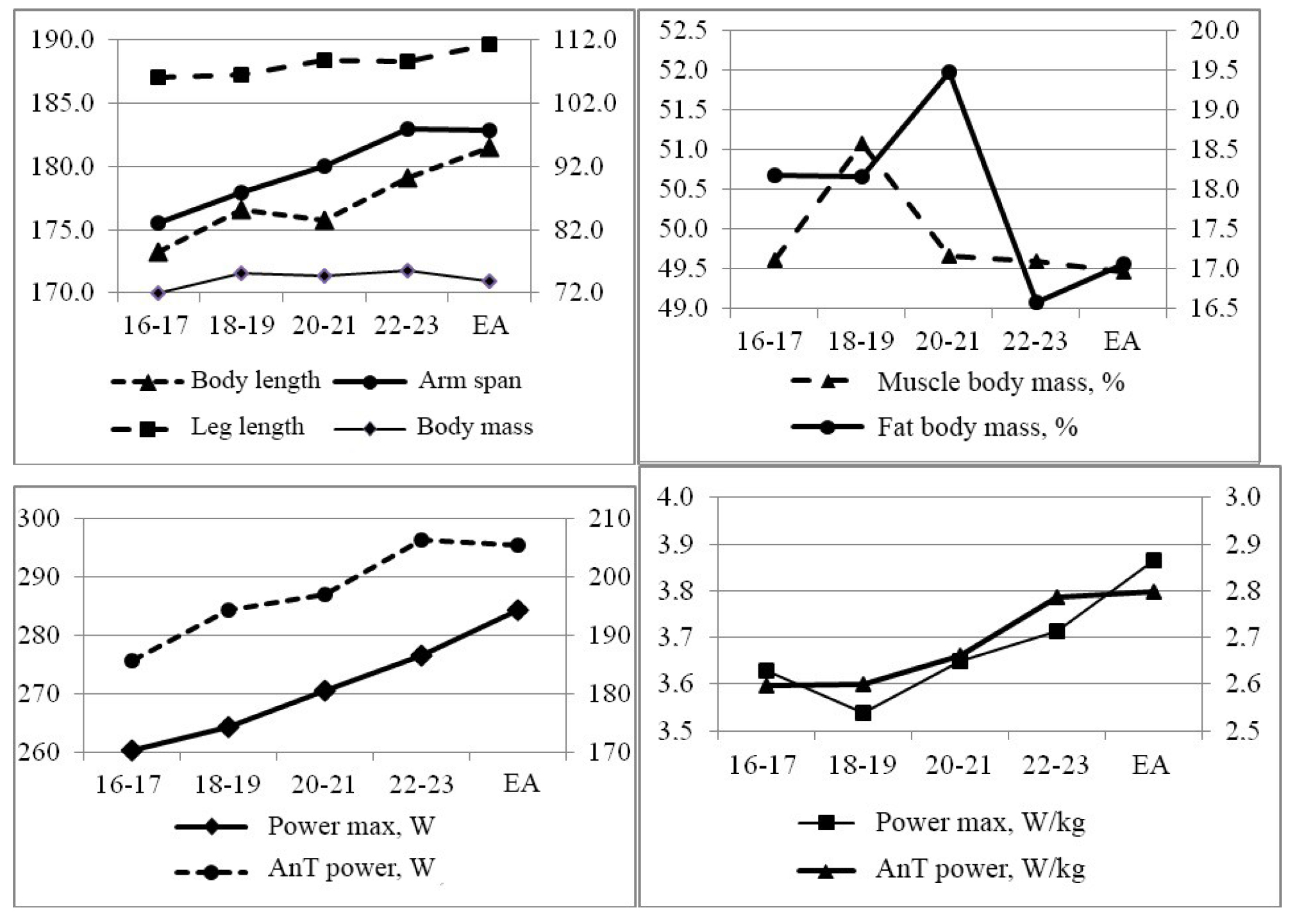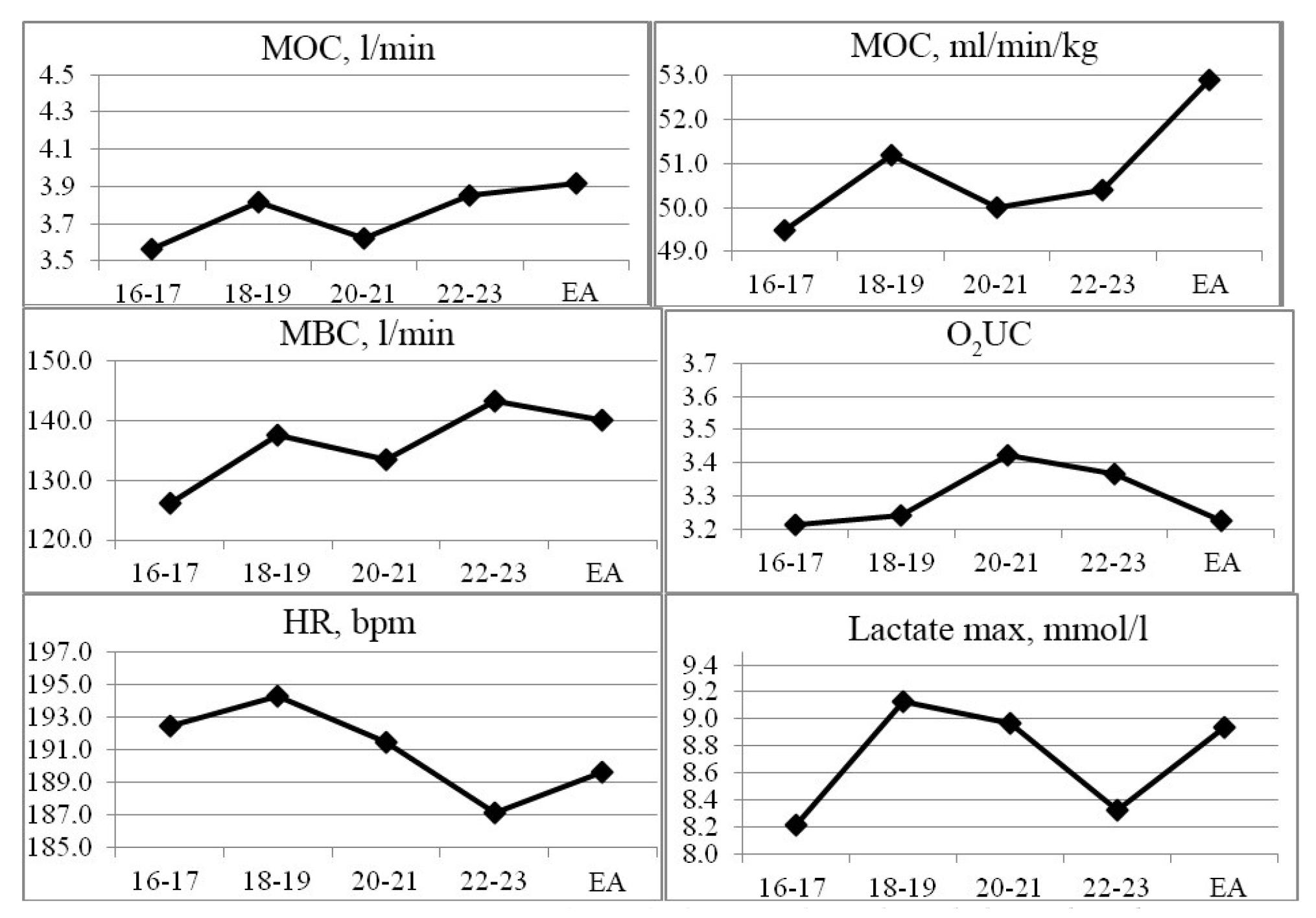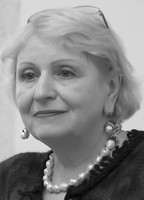Age-specific dynamics of physical working capacity and functionality at female rowers' training process stages
Фотографии:
ˑ:
T.F. Abramova
T.M. Nikitina
N.M. Yakutovich
All-Russian Research Institute of Physical Culture and Sport, Moscow
Keywords: age, body build, functionality, physical fitness.
Introduction. The sporting achievements, assessed by the mid-range places taken at the 2013-2015 World Cups and Championships, differ significantly by the rate and direction of changes occurring at different stages of centralized training of female rowers. For the first three years of the Olympic cycle, the directed growth of the Russian national junior team performance rates (from the 24th to the 8th place at the World Cup, along with the increasing number of delegations from 2 to 4-5, and winning silver and gold medals) was coupled with the relative stability of competitive results demonstrated by the female junior athletes (8th-9th places at the World Cup, increasing number of delegations from 4 to 6, and winning silver and gold medals), amid the directed and pronounced reduction of sports achievements of the first team athletes from the 8th to the 13th mid-range place at the World Championship, the number of delegation representatives being equal. This testifies to the loss of the competitive edge, progressing from junior to first team, one of the main reasons for which could be the directed decrease or lack of increase in the level of physical fitness of female athletes as a result of forced training at the junior team level, limiting further harmonious development of the functional rowing support system in terms of objectively increasing requirements for competitive activity on the international arena.
Objective of the study was to identify the age-specific variations in the indices of the morphofunctional state and physical fitness of rowers as the performance potential at the stages of sport excellence and top athletic mastery training period.
Methods and structure of the study. Subject to the study were 80 female athletes specializing in rowing (aged 16-35 years, qualifying period - 2-20 years, qualification - II Class to MSIC) (Table 2). The age groups were formed based on the rowing classification. At the same time, when the athletes were grouped at the top athletic mastery stage, the junior and youth teams were divided into the subgroups. The study involved cross-sectional and longitudinal surveys carried out within the framework of methodological support of the athletic training; the case follow-up involved 28% of all subjects.
Table 1. Characteristics of the athletes under study
|
Age groups, years old |
N |
Age, years old |
Qualifying period, Years |
Qualification, % |
|||||
|
II Class |
I Class |
CMS |
MS |
MSIC |
HMS |
||||
|
16-17 |
16 |
16.4 |
4.4 |
- |
25.0 |
68.8 |
6.2 |
- |
- |
|
18-19 |
20 |
18.5 |
4.8 |
- |
- |
95.0 |
5.0 |
- |
- |
|
20-21 |
19 |
20.4 |
6.0 |
- |
- |
78.9 |
21.1 |
- |
- |
|
22-23 |
12 |
22.5 |
6.9 |
- |
- |
33.3 |
66.7 |
- |
- |
|
Elite athletes, over 23 y.o. |
13 |
27.4 |
13.4 |
- |
- |
- |
46.2 |
53.8 |
- |

The following methods were used during the study: anthropometrics, callipering [1]; ergometry: step test "to failure" on the rowing ergometer Concept II (initial power for men - 150 W, for women - 100 W, surplus level - 50 W; step duration - 3 min, rest duration between the steps - 1 min); gasometry (automatic gas analyzer Oxycon Pro, ERICH JAEGER Company, GmbH, Germany); pulsometry, tonometry, test for lactate concentration (before workload, during workload and during recovery period). These methods were used to measure: total body sizes, leg length and arm span, muscle and fat body mass; indicators of aerobic performance (maximum power, maximum oxygen consumption - MOC, abs. and rel.; maximum breathing capacity - MBC; oxygen uptake coefficient - O2UC; HR max; oxygen pulse – OP); anaerobic threshold power, lactate max. Mathematical methods of data processing included descriptive statistics, correlation analysis [2].
Results and discussion. The level, direction and intensity of changes in the morphofunctional characteristics, ensuring special physical fitness of the rowers in the age period covering the time of athletic performance on the international arena as the youth, junior and first Russian national team members, make it possible to determine the peculiarities of formation or development of individual fitness components and the degree of compliance with the requirements of the sport (Tables 2 and 3, Figure).
Table 2. Age-related dynamics of indices of morphofunctional supply and physical working capacity of female rowers at different stages of sport excellence and top athletic mastery training.
|
Age groups |
16-17 y.o. |
18-19 y.o. |
20-21 y.o. |
22-23 y.o. |
Elite athletes |
|||||
|
Parameters |
|
Σ |
|
Σ |
|
σ |
|
σ |
|
Σ |
|
Body length, cm |
173.2 |
4.67 |
176.6 |
5.35 |
175.7 |
4.94 |
179.1 |
6.73 |
181.5 |
5.62 |
|
Arm span, cm |
175.6 |
5.45 |
177.9 |
6.17 |
180.0 |
8.18 |
183.0 |
11.6 |
182.8 |
5.52 |
|
Buttock-leg length, cm |
106.2 |
2.11 |
106.5 |
3.94 |
108.8 |
3.84 |
108.6 |
6.58 |
111.4 |
4.74 |
|
Body mass, kg |
72.0 |
5.99 |
75.1 |
7.66 |
74.6 |
7.55 |
75.5 |
10.8 |
73.8 |
5.14 |
|
Muscle body mass, % |
49.6 |
1.75 |
51.1 |
2.07 |
49.7 |
2.78 |
49.6 |
2.51 |
49.5 |
2.84 |
|
Fat body mass, % |
18.2 |
3.56 |
18.2 |
4.19 |
19.5 |
6.58 |
16.6 |
3.27 |
17.1 |
3.70 |
|
Hand strength, dn |
34.9 |
5.51 |
34.7 |
7.09 |
36.4 |
5.39 |
39.0 |
7.80 |
41.8 |
4.28 |
|
Maximum power, W |
260.2 |
20.2 |
264.3 |
25.9 |
270.6 |
28.4 |
276.5 |
27.6 |
284.2 |
23.6 |
|
Maximum power, W/kg |
3.63 |
0.31 |
3.54 |
0.37 |
3.65 |
0.44 |
3.71 |
0.51 |
3.87 |
0.40 |
|
MOC, l/min |
3.57 |
0.27 |
3.82 |
0.42 |
3.62 |
0.32 |
3.85 |
0.28 |
3.91 |
0.27 |
|
MOC, ml/min/kg |
49.53 |
3.51 |
51.22 |
5.08 |
49.97 |
5.50 |
50.37 |
5.46 |
52.93 |
4.89 |
|
MBC, l/min |
126.2 |
13.1 |
137.6 |
18.6 |
133.4 |
17.5 |
143.3 |
10.3 |
140.2 |
13.8 |
|
O2UC, c.u. |
3.21 |
0.55 |
3.24 |
0.47 |
3.42 |
0.50 |
3.37 |
0.35 |
3.23 |
0.34 |
|
HR max, bpm |
192.4 |
5.70 |
194.3 |
7.51 |
191.5 |
10.1 |
187.1 |
9.69 |
189.6 |
7.17 |
|
OP, ml/b |
18.60 |
1.63 |
19.67 |
2.32 |
18.96 |
1.86 |
20.59 |
1.24 |
20.64 |
1.08 |
|
Lactate max, mmol/l |
8.22 |
1.55 |
9.12 |
1.74 |
8.97 |
1.52 |
8.33 |
1.34 |
8.94 |
2.20 |
|
AnT power, W |
185.7 |
21.3 |
194.2 |
25.6 |
196.9 |
22.1 |
206.3 |
22.4 |
205.3 |
20.9 |
|
AnT power, W/kg |
2.60 |
0.37 |
2.60 |
0.36 |
2.66 |
0.37 |
2.79 |
0.51 |
2.80 |
0.37 |
|
OC AnT, l/min |
3.05 |
0.29 |
3.28 |
0.35 |
3.10 |
0.39 |
3.24 |
0.36 |
3.27 |
0.21 |
|
LV AnT, l/min |
97.82 |
9.65 |
113.6 |
26.2 |
107.5 |
20.1 |
119.4 |
26.9 |
100.2 |
22.7 |
|
HR AnT, bpm |
179.4 |
4.63 |
181.2 |
6.99 |
177.9 |
8.53 |
173.9 |
10.7 |
174.5 |
6.37 |
|
% OC AnT of MOC |
86.47 |
5.96 |
85.47 |
5.12 |
85.59 |
6.34 |
84.36 |
7.29 |
83.54 |
3.62 |

Age-related dynamics of indices of morphofunctional supply and physical working capacity of female rowers at different stages of sport excellence and top athletic mastery training
Table 2. Changes in physical working capacity rates and morphofunctional abilities of female rowers of different age, %
|
Indicators |
Age groups, y.o. |
||||
|
16-17/ 18-19 |
18-19 / 20-21 |
20-21/ 22-23 |
22-23 / Elite athletes |
16-17/ Elite athletes |
|
|
MBC, abs. |
9.0 |
-3.0 |
7.4 |
-2.1 |
11.1 |
|
OP, ml/min |
5.8 |
-3.6 |
8.6 |
0.2 |
11.0 |
|
AnT power, аbs. |
4.6 |
1.4 |
4.8 |
-0.5 |
10.6 |
|
MOC, abs. |
7.0 |
-5.1 |
6.3 |
1.7 |
9.5 |
|
Maximum power, abs. |
1.5 |
2.4 |
2.2 |
2.8 |
9.2 |
|
Lactate max, mmol/l |
11.1 |
-1.7 |
-7.1 |
7.3 |
8.8 |
|
AnT power, rel. |
0.2 |
2.3 |
4.7 |
0.4 |
7.7 |
|
MOC, rel. |
3.4 |
-2.4 |
0.8 |
5.1 |
6.9 |
|
Maximum power, rel. |
-2.5 |
3.1 |
1.7 |
4.1 |
6.6 |
|
Fat body mass, % |
-0.1 |
7.3 |
-14.9 |
2.9 |
-6.0 |
|
Body length, cm |
2 |
-0.5 |
1.9 |
1.4 |
4.8 |
|
Body mass, kg |
4.3 |
-0.6 |
1.2 |
-2.3 |
2.5 |
|
HR max, bpm |
0.9 |
-1.4 |
-2.3 |
1.3 |
-1.5 |
|
O2UC, c.u. |
0.9 |
5.7 |
-1.7 |
-4.1 |
0.6 |
It is shown that the main age-related trends in the development of the female rowers’ fitness components are characterized by the following aspects: directed growth to achieve maximal power manifestations of the working capacity, oxygen pulse, MOC by means of ventilation capabilities, which is supplemented by a decrease of the muscle and fat body mass to its minimum, as well as a decrease of O2UC resulting from the progressive development disorder in the individual fitness components at various stages of physical training. Formation of the indicators of physical working capacity and supply functions in the female group is associated with the indicators of the lactacid energy supply and aerobic and anaerobic transition, demonstrating the antagonism in the pace of development of power of these energy supply systems.
Over the entire period of centralized training at the level of youth, junior and first national teams (16-17 years to EA), the physical fitness building in female rowers is primarily due to the optimization of the regulatory mechanisms of the cardiorespiratory system, which is correlated with the activation of the ventilation. At the same time, there is a relatively harmonious, less evident development of the absolute and relative power of oxidation, aerobic and anaerobic transition and lactacid energy supply systems. MOC is formed by means of an increase in MBC under the conditions of consistent low oxygen uptake by the muscles.
The maximal shifts in the functional indices of the female athletes are typical for youth training - from 16-17 to 18-19 years, with a preferential increase in the power of the lactacid and oxidation (by means of ventilation) systems in terms of increasing intensity of the cardiovascular system response against the stability of the power characteristics of the maximimal and AnT . The minimum shifts in the working capacity are typical for the period of transition from the category of girls to juniors with manifestation of the function economization (18-19 to 20-21 years). The fundamental change of the shift direction is typical for young athletes (20-21 to 22-23 years) training, when a relatively harmonious development of physical working capacity is achieved through the optimization of the cardiorespiratory system, aerobic glycolysis system and aerobic and anaerobic transition. Varying fitness indicators when proceeding to the category of EA relate to the increase of the power of the lactacid and oxidation systems that ensure the maximum power increase without any shifts at the level of the AnT power.
At the stage of top athletic mastery, elite female rowers’ sports activity is characterized by a more or less formed functional system; they demonstrate the highest, yet low, power indices of working capacity, both during the ultimate realization and at the level of aerobic and anaerobic transition [3] as a result of the highest, yet low, level of developing power of the oxidation and glycolytic energy supply systems in the context of sustainable development of the regulatory mechanisms of the cardiorespiratory system.
In conclusion, it should be noted that during the entire experimental period the power, functional and regulatory indicators of the female rowers’ physical fitness developed wave-like in the sequence as follows:
– maximum functionality growth rate with the preferential predominance of the oxidation and lactacid systems, low level of readiness of the inter-system regulatory mechanisms;
– minimum variations in the working capacity along with economization of the functional support of sports activity;
– maximum rate of increase in the fitness indices with the focus on the development of the aerobic and anaerobic energy supply mechanism in terms of harmonization of the regulatory mechanisms of the cardiorespiratory system;
– maximum rate of increase of the working capacity with the focus on increasing power of the lactacid system at a minimum rate of changes in the power of aerobic and anaerobic transition and negative changes in the oxygen uptake by the muscles.
Conclusion. The study findings indicate that this chronology of physical fitness development, coupled with high frequency of involvement of the new female athletes, who had been subject to regional training before qualifying for the teams, disturbs the succession in the gradual and harmonious formation of the power and regulatory characteristics of physical capacity of the female rowers.
References
- Abramova T.F., Nikitina T.M., Kochetkova N.I. Labilnye komponenty massy tela – kriterii obshchey fizicheskoy podgotovlennosti i kontrolya tekushchey i dolgovremennoy adaptatsii k trenirovochnym nagruzkam: metodicheskie rekomendatsii [Labile components of body weight - criteria for all-round fitness and control of current and long-term adaptation to training loads: guidelines]. Moscow: Skyprint publ., 2013, 132 p.
- Deryabin V.E. Kurs lektsiy po mnogomernoy biometrii dlya antropologov [Lectures on multivariate biometrics for anthropologists]. Moscow: MSU publ., 2008, 328 p.
- Hagerman F.C. Applied physiology of rowing. Sports Medicine, 1984, no. 1, pp. 303-326.
Corresponding author: vniifk@yandex.ru
Abstract
Competitive success in modern sports is often largely limited by the training loads being prematurely intensified with poor if any consideration for the core energy systems growth and development logics. The study was designed to analyse the age-specific variations of body build, working capacity and energy supply rates in 80 subject female rowers of 16-35 years of age in the sport excellence to the top athletic mastery training period. The following methods were applied in the study: anthropometrics, callipering, biochemical analysis of blood, functionality tests (physical working capacity, external respiration rating tests), and heart rate measurements. The study data and analyses gave the means to find the morphological and functional state development and physical working capacity formation logics in female rowers in every sport excellence stage. The study findings showed the traditional physical development and training chronology – with the new regionally trained athletes being prematurely included in the teams – forming a gap in succession and development of the strength and regulatory aspects of the athletic physical resources.




